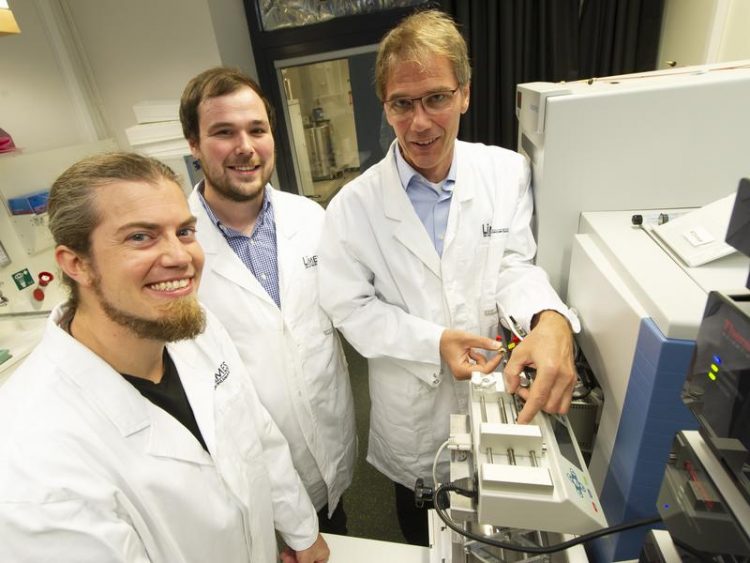Shipment tracking for "fat parcels" in the body

In the lab: (from left) Klaus Wunderling, Philipp Leyendecker and Prof. Dr. Christoph Thiele at the LIMES-Institute at the University of Bonn. © Photo: Barbara Frommann/Uni Bonn
Many people think of the padding on their stomach or hips when they hear the term “body fat”. “But no human being could survive without lipids, as these substances are called in chemistry,” says Prof. Dr. Christoph Thiele from the LIMES Institute at the University of Bonn.
Because fats are important energy stores. For instance, if the fat metabolism in cancer patients is disrupted, the result is dramatic weight loss. In addition, lipids often serve as building blocks for the envelopes of living cells, such as brain cells. This is why disorders can also lead to neurological diseases.
Scientists are therefore searching for methods that enable them to track the path from the uptake of fats through the metabolism in the body to excretion using a kind of “tracking” process – similar to a posted parcel that can be tracked on its way to its destination. Previously, researchers used radioactive substances, fluorescent dyes or heavy isotopes of hydrogen-2 (deuterium) to mark the “fat parcels”.
“The problem with this is that the marked compounds cannot be fully distinguished from the unmarked ones,” explains Thiele. This means that only a few marked main compounds can be traced and that quite large amounts of substance are required for this.
Decay reactions lead to strong signals during measurement
Together with his team colleagues Klaus Wunderling and Philipp Leyendecker, the biochemist has now shown how fats can be traced in the body of mice using a much more sensitive and effective method. They added fatty acids to the liver cells of the mice, which were marked with an additional triple bond, a so-called alkyne group. Subsequently, the metabolic products bound to special so-called reporter molecules.
In a further step, the compounds collided with gas molecules while their weight was being measured in the mass spectrometer, causing them to decompose into specific substances on which the markings finally became visible.
“This decay reaction produces very strong signals for the marked lipids in the mass spectrometer,” said Thiele. This allows a clearer distinction between marked and unmarked lipids, and the measurements are about 1000 times more sensitive than with conventional methods. In addition, it is much faster: Results take minutes instead of hours.
“Around 100 different marked lipids can actually be traced down into individual liver cells,” explains the biochemist. This makes it possible to examine both the normal metabolic pathway and pathological deviations in detail. The examination of mouse liver cells was an obvious choice for the researchers because the liver is the “main hub” for fat metabolism.
However, this method is not yet suitable for human nutrition experiments. “We still don't know exactly what the fatty acids coupled to alkyne groups do in the human body when they are ingested with food,” says Thiele.
Nevertheless, the researcher is convinced that this method could be used to investigate the side effects of drugs on fat metabolism and possibly reduce these considerably. As consumption experiments on humans are currently not possible, the side effects could be tested on cell cultures or organoids. Thiele: “This makes it easy to see how the lipid metabolism is altered by the active substances.”
Prof. Dr. Christoph Thiele
University of Bonn
Life & Medical Sciences Institute (LIMES)
Tel. +49-228-7362818
E-mail: cthiele@uni-bonn.de
Christoph Thiele, Klaus Wunderling, Philipp Leyendecker: Multiplexed and single cell tracing of lipid metabolism, Nature Methods, DOI: 10.1038/s41592-019-0593-6
Media Contact
More Information:
http://www.uni-bonn.de/All latest news from the category: Health and Medicine
This subject area encompasses research and studies in the field of human medicine.
Among the wide-ranging list of topics covered here are anesthesiology, anatomy, surgery, human genetics, hygiene and environmental medicine, internal medicine, neurology, pharmacology, physiology, urology and dental medicine.
Newest articles

Time to Leave Home? Revealed Insights into Brood Care of Cichlids
Shell-dwelling cichlids take intense care of their offspring, which they raise in abandoned snail shells. A team at the Max Planck Institute for Biological Intelligence used 3D-printed snail shells to…

Smart Fabrics: Innovative Comfortable Wearable Tech
Researchers have demonstrated new wearable technologies that both generate electricity from human movement and improve the comfort of the technology for the people wearing them. The work stems from an…

Going Steady—Study Reveals North Atlantic’s Gulf Stream Remains Robust
A study by the University of Bern and the Woods Hole Oceanographic Institution in the USA concludes that the ocean circulation in the North Atlantic, which includes the Gulf Stream,…



